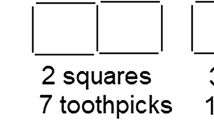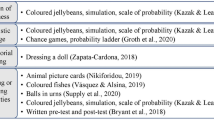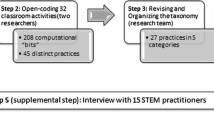Abstract
This paper describes a classroom experiment where students use techniques found in the history of mathematics to learn about an important mathematical idea. More precisely, sixth graders in a primary school follow Archimedes’s method of exhaustion in order to compute the number π. Working in a computer environment, students inscribe and circumscribe regular polygons inside and around a circle in order to find the approximate area of the circle. They then compute the ratio of that approximation to the area of a square with side-length equal to the radius of the circle. This ratio indicates how many times larger the area of the circle is than the area of the square. Mirroring Archimedes’s findings, students discover that as they increase the number of sides in their polygons, the numerical results they obtain convince them that this number is almost equal to 3.14.











Similar content being viewed by others
Notes
In December 2002, computer scientists Kanada, Ushio and Kuroda, University of Tokyo, Japan, computed π to a world record 1.2411 × 1012 (more than one trillion) decimal digits. The computation consumed more than 600 h of time of a Hitachi SR8000 super computer (www.super-computing.org/pi_current.html. Accessed 23 October 2012).
References
Burton, D. M. (2011). The history of mathematics. An introduction (7th ed.). New york: McGraw-Hill.
Castellanos, D. (1988). The ubiquitous Pi. Mathematics Magazine, 61(2), 67–98.
Clark, K. M. (2012). History of Mathematics: illuminating understanding of school mathematics concepts for prospective mathematics teachers. Educational Studies in Mathematics, 81(1), 67–84.
Costabile, F., & Serpe, A. (2010). Archimedes in secondary schools: A teaching proposal for the math curriculum. In S. A. Paipetis & M. Ceccarelli (Eds.), The genius of Archimedes: 23 centuries of influence on mathematics, science and engineering (Vol. 11, pp. 479–491)., History of Mechanism and Machine Science Netherlands: Springer.
Furinghetti, F. (2002). On the role of the history of mathematics in mathematics education. In Paper presented at 2 nd international conference on the teaching of mathematics at the undergraduate level. Crete, Greece.
Galton, D. (2009). The magic of Pi (π): Coda. The Quarterly Journal of Medicine, 102(6), 439–440.
Gulikers, I., & Blom, K. (2001). ‘A historical angle’. A survey of recent literature on the use and value of history in geometrical education. Educational Studies in Mathematics, 47(2), 223–258.
Harel, G., & Sowder, L. (2007). Toward comprehensive perspective on the learning and teaching of proof. In F. K. Lester Jr (Ed.), Second handbook of research on mathematics teaching and learning (pp. 805–842). Charlotte: National Council of Teachers of Mathematics.
Harris, H. (1959). The history and calculation of Pi. The Emporia State Research Studies, 8(1), 5–39.
Jankvist, U. T. (2009). A categorization of the “whys” and “hows” of using history in mathematics education. Educational Studies in Mathematics, 71(3), 235–261.
Jankvist, U. T. (2011). Essay Review. A century of mathematics education: ICMI’s first hundred years. Historia Mathematics, 38(2), 292–302.
Kahn, K., Sendova, E., Sacristan, A. I., & Noss, R. (2011). Young students exploring cardinality by constructing infinite processes. Technology, Knowledge and Learning, 16(1), 3–34.
Kjeldsen, T. H., & Blomhøj, M. (2012). Beyond motivation: History as a method for learning meta-discursive rules in mathematics. Educational Studies in Mathematics, 80(3), 327–349.
Lang, S. (1985). Math!: Encounters with high school students. New York: Springer.
Mason, J., Burton, L., & Stacey, K. (1982). Thinking mathematically. New York: Addison Wesley.
Mason, R., & Janzen Roth, E. (2005). Thinking like Archimedes: An instructional design experiment. In Proceedings of the eight international congress of the history, plilosophy, sociology and science teaching, Leeds, UK, www.ihpst2005.leeds.ac.uk/papers.htm. Accessed 10 October 2012.
Michalowicz, K. D. (2000). History in support of diverse educational requirements: Opportunities for change. In J. Fauvel & J. van Mannen (Eds.), History in mathematics education: The ICMI study (pp. 172–200). Dordrecht: Kluwer.
Schoenfeld, A. H. (2007). Method. In F. K. Lester Jr (Ed.), Second handbook of research on mathematics teaching and learning (pp. 69–107). Charlotte: Information Age Publishing.
Sfard, A. (1991). On the dual nature of mathematical conceptions. Educational Studies in Mathematics, 22(1), 1–36.
Siu, M. K., & Tzanakis, C. (2004). History of mathematics in classroom: Appetizer? Main course? or dessert? Mediterranean Journal for Research in Mathematics Education, 3(1-2), v–x.
Smestad, B. (2012). Not just “telling stories”. History of mathematics for teacher students: What is it and how to teach it. Paper presented in ICME-12, Seoul, Korea, Retrieved from, www.icme12.org/upload/UpFile2/TSG/0484.pdf. Accessed 20 May 2013.
Author information
Authors and Affiliations
Corresponding author
Rights and permissions
About this article
Cite this article
Papadopoulos, I. How Archimedes Helped Students to Unravel the Mystery of the Magical Number Pi. Sci & Educ 23, 61–77 (2014). https://doi.org/10.1007/s11191-013-9643-0
Published:
Issue Date:
DOI: https://doi.org/10.1007/s11191-013-9643-0




